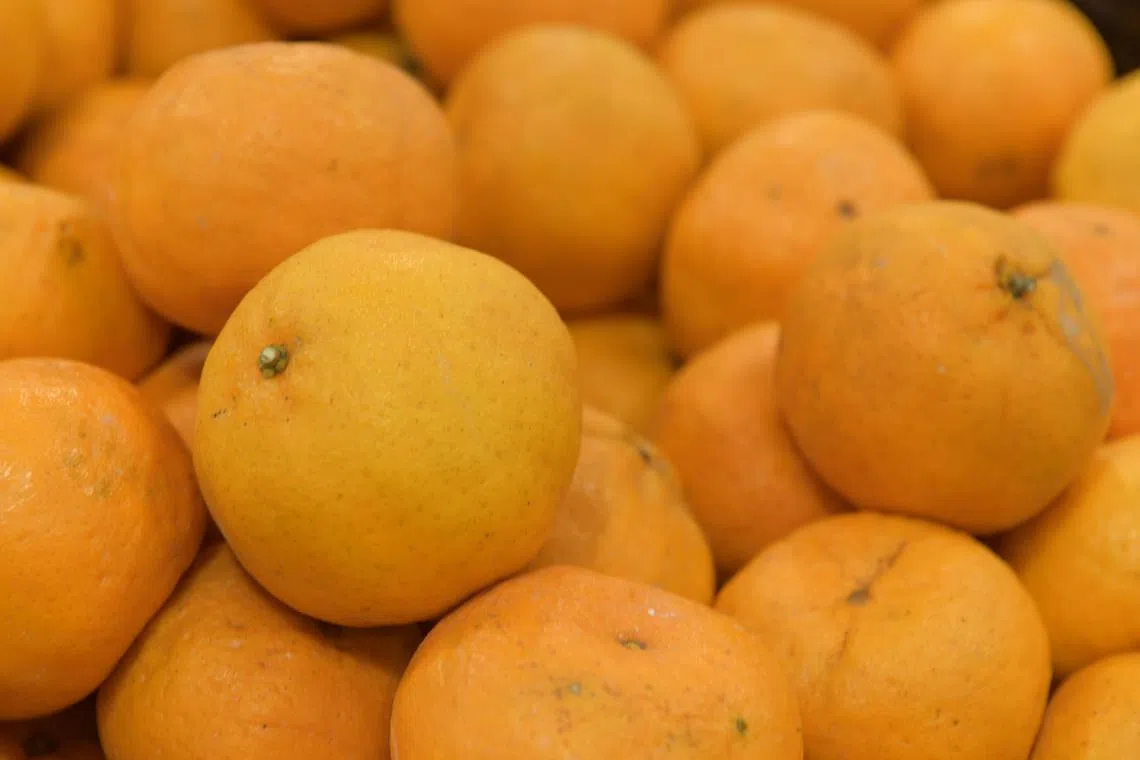What has Christmas got to do with the mandarin orange? 5 things to know about the CNY staple
Sign up now: Get ST's newsletters delivered to your inbox

In Cantonese, to gift mandarin oranges is to “song gam” - which has a dual meaning of “giving gold” and thus signifies a wish of prosperity and wealth upon the recipient.
ST PHOTO: NG SOR LUAN
Follow topic:
SINGAPORE - A hallmark of Chinese New Year, the sight of mandarin oranges each year signals that the festive season has officially begun.
In Cantonese, to gift mandarin oranges is to “song gam” - which has a dual meaning of “giving gold” and thus signifies a wish of prosperity and wealth upon the recipient.
The oranges are also always given in pairs as odd numbers are considered bad luck in Chinese tradition; as the familiar Mandarin saying goes - “hao shi cheng shuang”, or “good things come in pairs”.
Here are some other mandarin orange facts to slide into conversations this Year of the Snake.
1. Why are they called mandarin oranges?
According to the National Library Board’s Singapore Infopedia, the word “mandarin” was used by the English to reference Chinese government officials.
Introduced to the West by China at the turn of the 19th century, the fruit was thus bestowed the fitting name of “mandarin”.
But they are also known as “kid-glove” or “loose-skin” oranges to some, owing to their distinct easy-to-peel skin.
Mandarin oranges today can be easily found in Japan, the East Indies, India, Australia and almost all tropical, sub-tropical and cooler parts of the world.
2. How many types of mandarin oranges are there?
There are more than 10 different varieties of mandarin oranges.
Some have been crossed with other citrus fruits, such as the pomelo and tangerine, each with their own unique flavour profile and nuances in appearance.
The ponkan, for instance, is a long-time favourite because of its sweetness and easily peeled puffy skin. The swatow, on the other hand, is for people who like anything “siu dai”, as it is less sweet.
Other popular varieties include the lukan, kinno, and red beauty - an up-and-coming variety known for its jelly-like flesh.
3. Not always cheap
Mandarin orange prices can range widely based on their variety.
The CNN reported in 2020 about a crate of just 100 Japanese mikan mandarins which sold for 1 million yen (S$8,733) at an auction in Tokyo’s central wholesale Ota Market.
Also known as unshiu mikan, or satsuma oranges, these mandarins come from the south of Japan and have a history of about 400 years.
Closer to home, a box of six to eight dekopon oranges costs almost $96 at local retailer Skcfruits. For comparison, a box of 30 lukan oranges cost only $17 at your nearest FairPrice supermarket.
4. Links with Christmas
Also called Christmas oranges, they have become a part of that festive period in the United States and Canada.
The use of mandarin oranges in North America can be attributed to Japanese immigrants there in the late 1800s, who would often receive shipments of the fruit from friends and family as gifts for the New Year.
These citrusy fruits then became linked with Christmas, with oranges wrapped in green tissue a familiar sight during that holiday. Some also place mandarin oranges in Christmas stockings, with one theory being that they represent the bags of gold that Saint Nicholas - also known as Santa Claus and Father Christmas - gave to three poor women so that they could get married.

5. Other uses
Some more known ways mandarins are used are in cooking, baking, or made into syrups for fruity drinks. But did you know that these oranges also have medicinal properties?
The orange peel can be extracted for its essential oils, and used in aromatherapy and traditional medicine to treat insomnia, skin and digestive problems.
Other parts of the fruit and plant, such as the seeds, roots, leaves and flowers, are used in Chinese, Malay and Indian traditional medicine.
A good source of vitamin C and antioxidants, mandarin oranges are also great for the immune system, and is used to combat phlegm and prevent colds. Some varieties of mandarins also contain a decongestant called synephrine, which is also known to reduce appetite, as well as to increase energy and metabolism rates.
Christie Chiu is a journalist on The Straits Times’ breaking news team. She covers local and global current affairs and the latest trending topics.


